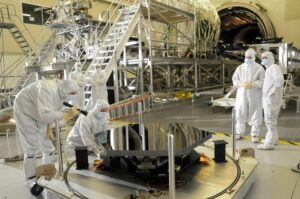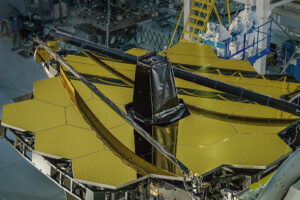The size of the telescope plays a crucial role in the collection of light, coming from the observed objects. Webb’s primary and gold mirror is 6.5 meters, which is 21 feet 4 inches around and is considered as the largest mirror ever launched into space.
Goals Of James Webb Science Telescope (JWST)
One of the utmost goals of James Webb is to look back through time when galaxies were young and just-made. Webb will perform this by observing the variety of distant galaxies, at around 13 billion light-years away from us.

Congregating abundant Goals of revealing the mysteries and ramping up the astronomy knowledge, James Webb is the uttermost telescope that is ever launched!
The Innovation Behind The New-fangled Mirror
It is an extremely strategic approach that a dedicated team has been set up to test various aspects of the James Webb, including the mirror, and the elements involved in a futuristic telescope to handle the management of the formation of the largest 6.5-meter mirror, and the cost allocated, for the rollout and launching of the telescope.
Must read- James Webb Space Telescope: Gimbaled Antenna Assembly finally Released
After many years of enormous research, the committed team recommended the Beryllium Mirror to involve in JWST. As Beryllium can hold the shape at cryogenic temperatures, it was consented to apply the Beryllium mirror in James Webb Space Telescope!
Why Only Beryllium Not Others for Webb?
Beryllium-
(a) Atomic Number- 4
(b) Atomic Symbol- Be
(c) Atomic Weight- 9.012182 u
Quick Read- Most Dominant & Unbelievable Mission NASA’s Parker Solar Probe Finally Touched the Sun
Beryllium is light and consummate metal to imply in telescopes. It has a good capability to sustain its shape at severe temperatures. Except for Magnet, Beryllium is the great conductor of heat and electricity.
Because of its light and strong property, Beryllium is used for space shuttles and supersonic airplanes, also, it takes part in springs and tools, which signifies its prodigious performance in diverse areas.
Read More- Current Location Of James Webb Space Telescope: Ultimate Guide After Launch
However, some stern measures must be adhered to while implementing the beryllium, as it is unhealthy and speculative to swallow its dust or to breathe it in!
The Unsurpassable James Webb’s Gold Coating
When the Beryllium mirror segment’s final shape is done, for every imaging effect caused by cold temperatures, including polishing of mirror, then a thin layer of gold coating is implemented over it.
More Story- Boom! Get an Exclusive Live Streaming Of James Webb Space Telescope
Why Gold?
Having atomic number 79 and atomic mass 196.96657 u, The Gold scientifically improves and maintains the mirror’s reflection of infrared light, which is used in the earlier launched James Webb Space Telescope.
How Is The Gold Applied to the mirrors?
It is unquestionably a notable thing to explore that how the gold got applied to the mirrors, which can improve the mirror’s reflection of infrared light.
So, Its answer is the Vacuum Vapour Deposition. For instance, Quantum Coating Incorporated did the coatings on the Beryllium mirrors of the James Webb Space Telescope (JWST).

Precisely, the mirrors were moved inside a vacuum chamber, and a small amount of gold is first vaporized and then, deposits on the respective James Webb’s mirror. And, the areas which were not required coatings got masked-off, while coating to the other respective parts.
More Story- Most Intricate Challenge in Space begins, Unfolding $10 bn James Webb Telescope
What’s Specific About the Gold Operated On Webb?
The Gold operated on Webb has a thickness of 1000 A°, equivalent to 100 nanometres. Along with this, a thin layer of amorphous SiO2 was deposited on the peak of the gold, to make it secure from scratches or obstructions, created by particles moving around.
What Type Of Telescope Is the James Webb?
Webb is considered as the three-mirror anastigmatic telescope, under which the primary mirror is concave and the secondary one is convex, which works around the off-axis.
Read More- Some Strange Facts Based On James Webb Space Telescope
To flatten the focal plane, and to essentially remove resulting astigmatism, the tertiary mirror involves in usage. It also assists to make the view wider.
Folding Mirrors of The Webb
To fit the mirror into the rocket, the setup team has planned to apply folding mirrors, which is highly foldable, and are easy in functioning.
After the launch of the James Webb, its mirrors got unfolded. The shape of the mirror is Hexagonal, and the total number of Hexagonal mirrors is 18, whose diameter is 1.32 meters (4.3 feet), flat to flat, while its secondary mirror is 0.74 meters in diameter.
Quick Read- Get a Detailed Overview of Hubble Space Telescope
Continue Reading- What’s the Webb’s Final Destination